Audit and Assurance Report: Key Concepts and Procedures in Auditing
VerifiedAdded on 2022/12/28
|14
|4534
|34
Report
AI Summary
This report provides a detailed analysis of audit and assurance principles. It begins with an introduction to the audit process and the importance of auditor independence, discussing various factors that impact it, such as the audit committee, size of the audit firm, and competitiveness within the audit service sector. The report then explores situations impacting auditor independence, threats to objectivity, and safeguards. Further, it delves into the concept of going concern, including indicators and procedures. The report also examines audit risk, its types, and the auditor's response, and concludes with a discussion on the differences between interim and final audits, along with their respective procedures. The report references various academic sources to support its findings.
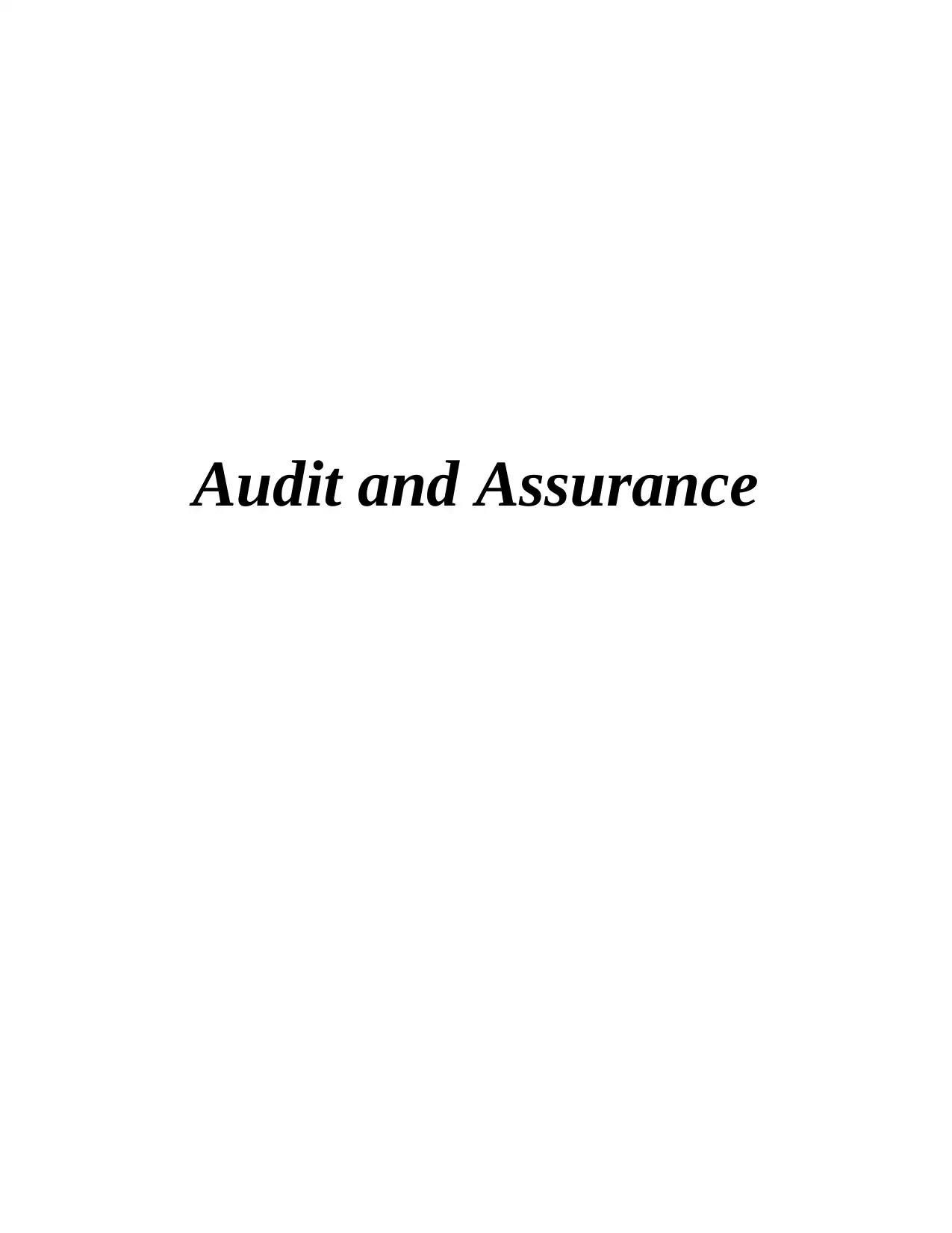
Audit and Assurance
Paraphrase This Document
Need a fresh take? Get an instant paraphrase of this document with our AI Paraphraser
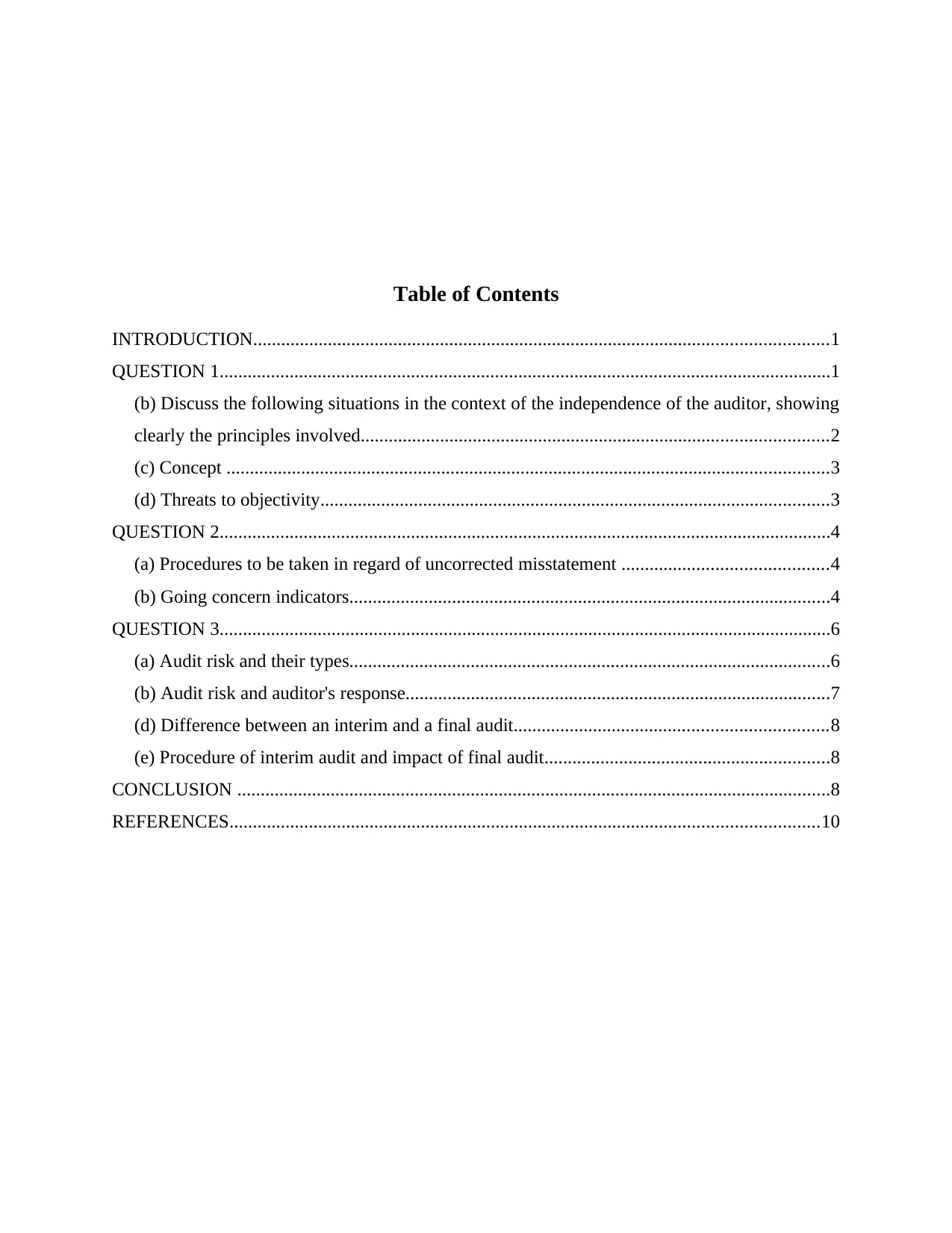
Table of Contents
INTRODUCTION...........................................................................................................................1
QUESTION 1...................................................................................................................................1
(b) Discuss the following situations in the context of the independence of the auditor, showing
clearly the principles involved....................................................................................................2
(c) Concept .................................................................................................................................3
(d) Threats to objectivity.............................................................................................................3
QUESTION 2...................................................................................................................................4
(a) Procedures to be taken in regard of uncorrected misstatement ............................................4
(b) Going concern indicators.......................................................................................................4
QUESTION 3...................................................................................................................................6
(a) Audit risk and their types.......................................................................................................6
(b) Audit risk and auditor's response...........................................................................................7
(d) Difference between an interim and a final audit...................................................................8
(e) Procedure of interim audit and impact of final audit.............................................................8
CONCLUSION ...............................................................................................................................8
REFERENCES..............................................................................................................................10
INTRODUCTION...........................................................................................................................1
QUESTION 1...................................................................................................................................1
(b) Discuss the following situations in the context of the independence of the auditor, showing
clearly the principles involved....................................................................................................2
(c) Concept .................................................................................................................................3
(d) Threats to objectivity.............................................................................................................3
QUESTION 2...................................................................................................................................4
(a) Procedures to be taken in regard of uncorrected misstatement ............................................4
(b) Going concern indicators.......................................................................................................4
QUESTION 3...................................................................................................................................6
(a) Audit risk and their types.......................................................................................................6
(b) Audit risk and auditor's response...........................................................................................7
(d) Difference between an interim and a final audit...................................................................8
(e) Procedure of interim audit and impact of final audit.............................................................8
CONCLUSION ...............................................................................................................................8
REFERENCES..............................................................................................................................10
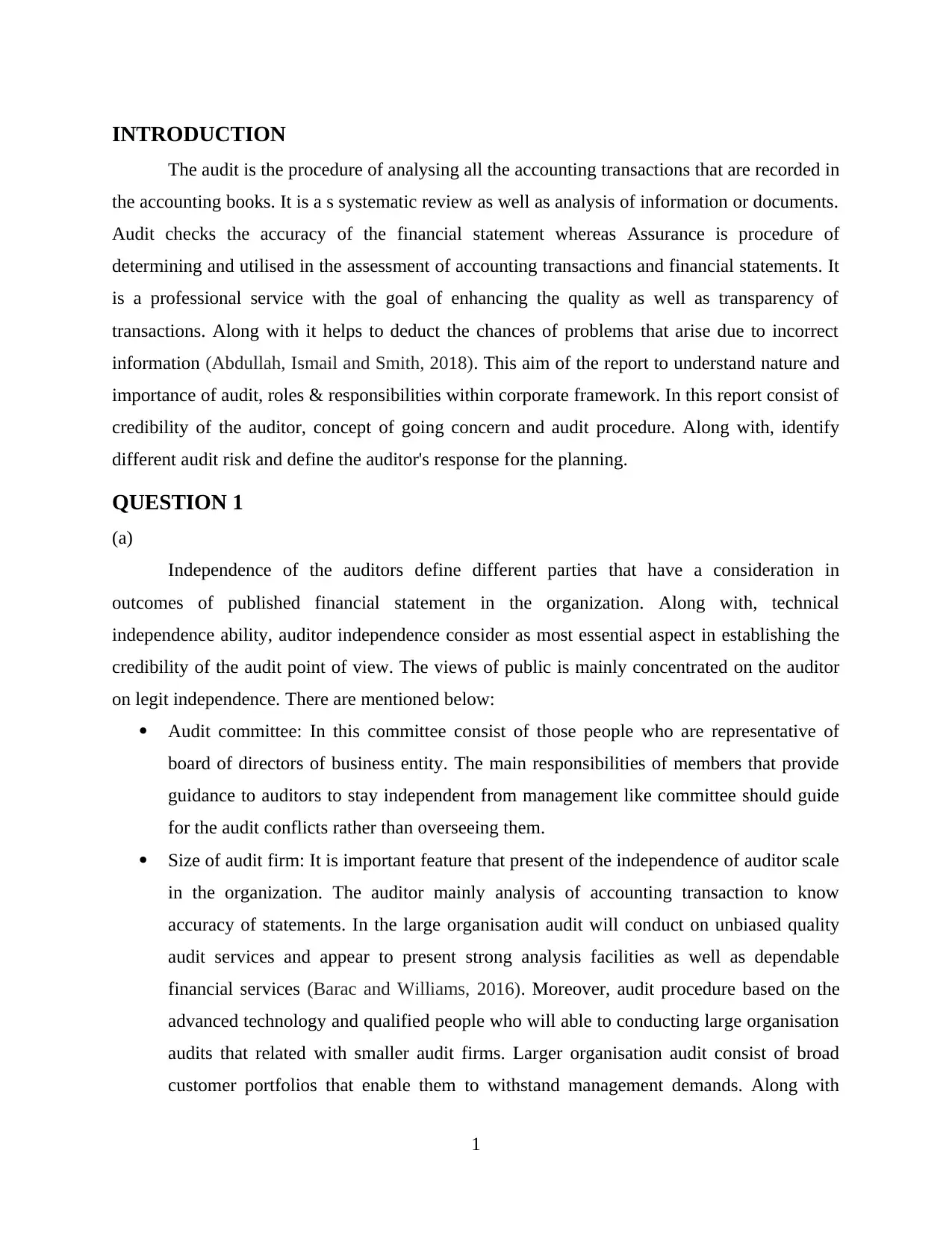
INTRODUCTION
The audit is the procedure of analysing all the accounting transactions that are recorded in
the accounting books. It is a s systematic review as well as analysis of information or documents.
Audit checks the accuracy of the financial statement whereas Assurance is procedure of
determining and utilised in the assessment of accounting transactions and financial statements. It
is a professional service with the goal of enhancing the quality as well as transparency of
transactions. Along with it helps to deduct the chances of problems that arise due to incorrect
information (Abdullah, Ismail and Smith, 2018). This aim of the report to understand nature and
importance of audit, roles & responsibilities within corporate framework. In this report consist of
credibility of the auditor, concept of going concern and audit procedure. Along with, identify
different audit risk and define the auditor's response for the planning.
QUESTION 1
(a)
Independence of the auditors define different parties that have a consideration in
outcomes of published financial statement in the organization. Along with, technical
independence ability, auditor independence consider as most essential aspect in establishing the
credibility of the audit point of view. The views of public is mainly concentrated on the auditor
on legit independence. There are mentioned below:
Audit committee: In this committee consist of those people who are representative of
board of directors of business entity. The main responsibilities of members that provide
guidance to auditors to stay independent from management like committee should guide
for the audit conflicts rather than overseeing them.
Size of audit firm: It is important feature that present of the independence of auditor scale
in the organization. The auditor mainly analysis of accounting transaction to know
accuracy of statements. In the large organisation audit will conduct on unbiased quality
audit services and appear to present strong analysis facilities as well as dependable
financial services (Barac and Williams, 2016). Moreover, audit procedure based on the
advanced technology and qualified people who will able to conducting large organisation
audits that related with smaller audit firms. Larger organisation audit consist of broad
customer portfolios that enable them to withstand management demands. Along with
1
The audit is the procedure of analysing all the accounting transactions that are recorded in
the accounting books. It is a s systematic review as well as analysis of information or documents.
Audit checks the accuracy of the financial statement whereas Assurance is procedure of
determining and utilised in the assessment of accounting transactions and financial statements. It
is a professional service with the goal of enhancing the quality as well as transparency of
transactions. Along with it helps to deduct the chances of problems that arise due to incorrect
information (Abdullah, Ismail and Smith, 2018). This aim of the report to understand nature and
importance of audit, roles & responsibilities within corporate framework. In this report consist of
credibility of the auditor, concept of going concern and audit procedure. Along with, identify
different audit risk and define the auditor's response for the planning.
QUESTION 1
(a)
Independence of the auditors define different parties that have a consideration in
outcomes of published financial statement in the organization. Along with, technical
independence ability, auditor independence consider as most essential aspect in establishing the
credibility of the audit point of view. The views of public is mainly concentrated on the auditor
on legit independence. There are mentioned below:
Audit committee: In this committee consist of those people who are representative of
board of directors of business entity. The main responsibilities of members that provide
guidance to auditors to stay independent from management like committee should guide
for the audit conflicts rather than overseeing them.
Size of audit firm: It is important feature that present of the independence of auditor scale
in the organization. The auditor mainly analysis of accounting transaction to know
accuracy of statements. In the large organisation audit will conduct on unbiased quality
audit services and appear to present strong analysis facilities as well as dependable
financial services (Barac and Williams, 2016). Moreover, audit procedure based on the
advanced technology and qualified people who will able to conducting large organisation
audits that related with smaller audit firms. Larger organisation audit consist of broad
customer portfolios that enable them to withstand management demands. Along with
1
⊘ This is a preview!⊘
Do you want full access?
Subscribe today to unlock all pages.

Trusted by 1+ million students worldwide
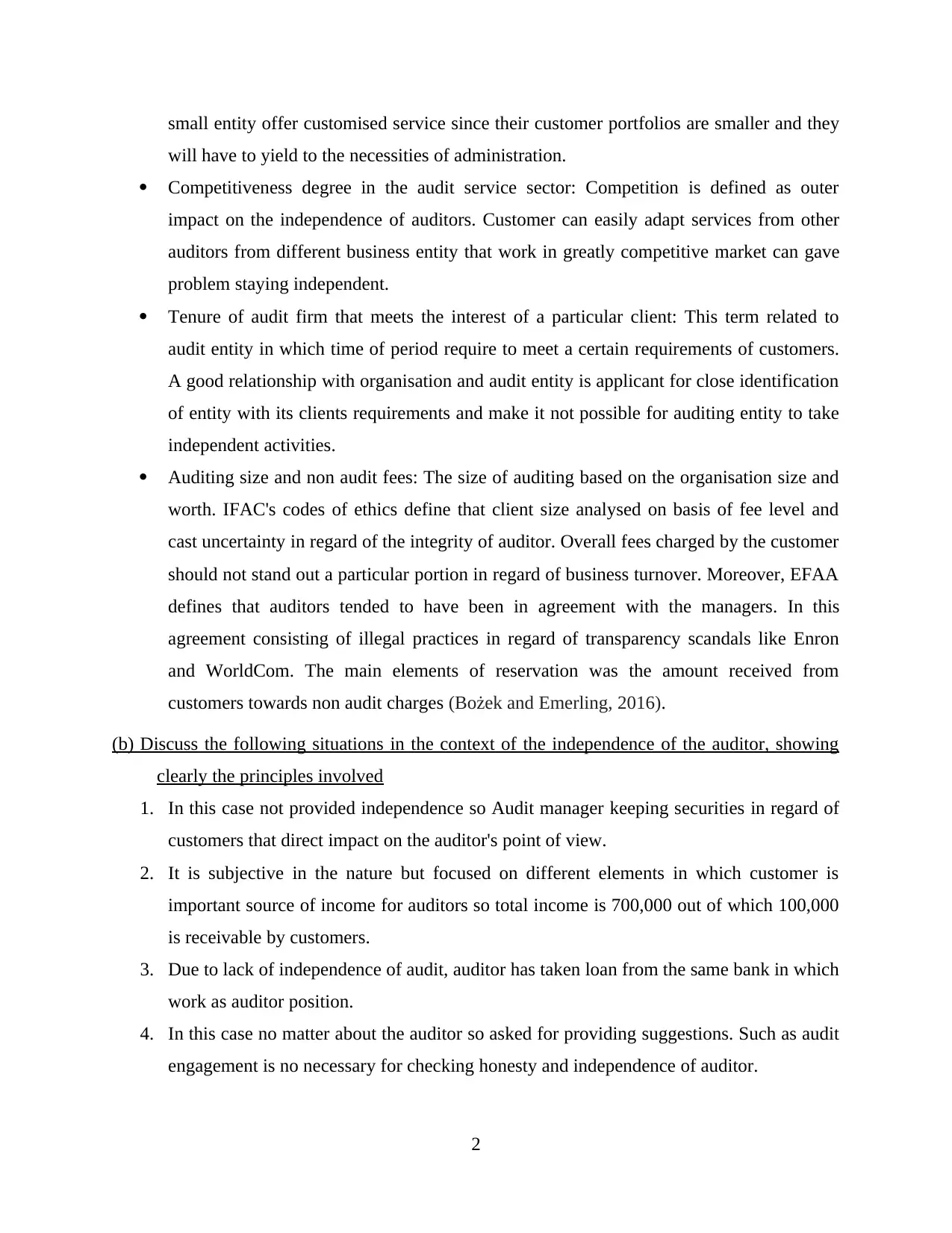
small entity offer customised service since their customer portfolios are smaller and they
will have to yield to the necessities of administration.
Competitiveness degree in the audit service sector: Competition is defined as outer
impact on the independence of auditors. Customer can easily adapt services from other
auditors from different business entity that work in greatly competitive market can gave
problem staying independent.
Tenure of audit firm that meets the interest of a particular client: This term related to
audit entity in which time of period require to meet a certain requirements of customers.
A good relationship with organisation and audit entity is applicant for close identification
of entity with its clients requirements and make it not possible for auditing entity to take
independent activities.
Auditing size and non audit fees: The size of auditing based on the organisation size and
worth. IFAC's codes of ethics define that client size analysed on basis of fee level and
cast uncertainty in regard of the integrity of auditor. Overall fees charged by the customer
should not stand out a particular portion in regard of business turnover. Moreover, EFAA
defines that auditors tended to have been in agreement with the managers. In this
agreement consisting of illegal practices in regard of transparency scandals like Enron
and WorldCom. The main elements of reservation was the amount received from
customers towards non audit charges (Bożek and Emerling, 2016).
(b) Discuss the following situations in the context of the independence of the auditor, showing
clearly the principles involved
1. In this case not provided independence so Audit manager keeping securities in regard of
customers that direct impact on the auditor's point of view.
2. It is subjective in the nature but focused on different elements in which customer is
important source of income for auditors so total income is 700,000 out of which 100,000
is receivable by customers.
3. Due to lack of independence of audit, auditor has taken loan from the same bank in which
work as auditor position.
4. In this case no matter about the auditor so asked for providing suggestions. Such as audit
engagement is no necessary for checking honesty and independence of auditor.
2
will have to yield to the necessities of administration.
Competitiveness degree in the audit service sector: Competition is defined as outer
impact on the independence of auditors. Customer can easily adapt services from other
auditors from different business entity that work in greatly competitive market can gave
problem staying independent.
Tenure of audit firm that meets the interest of a particular client: This term related to
audit entity in which time of period require to meet a certain requirements of customers.
A good relationship with organisation and audit entity is applicant for close identification
of entity with its clients requirements and make it not possible for auditing entity to take
independent activities.
Auditing size and non audit fees: The size of auditing based on the organisation size and
worth. IFAC's codes of ethics define that client size analysed on basis of fee level and
cast uncertainty in regard of the integrity of auditor. Overall fees charged by the customer
should not stand out a particular portion in regard of business turnover. Moreover, EFAA
defines that auditors tended to have been in agreement with the managers. In this
agreement consisting of illegal practices in regard of transparency scandals like Enron
and WorldCom. The main elements of reservation was the amount received from
customers towards non audit charges (Bożek and Emerling, 2016).
(b) Discuss the following situations in the context of the independence of the auditor, showing
clearly the principles involved
1. In this case not provided independence so Audit manager keeping securities in regard of
customers that direct impact on the auditor's point of view.
2. It is subjective in the nature but focused on different elements in which customer is
important source of income for auditors so total income is 700,000 out of which 100,000
is receivable by customers.
3. Due to lack of independence of audit, auditor has taken loan from the same bank in which
work as auditor position.
4. In this case no matter about the auditor so asked for providing suggestions. Such as audit
engagement is no necessary for checking honesty and independence of auditor.
2
Paraphrase This Document
Need a fresh take? Get an instant paraphrase of this document with our AI Paraphraser
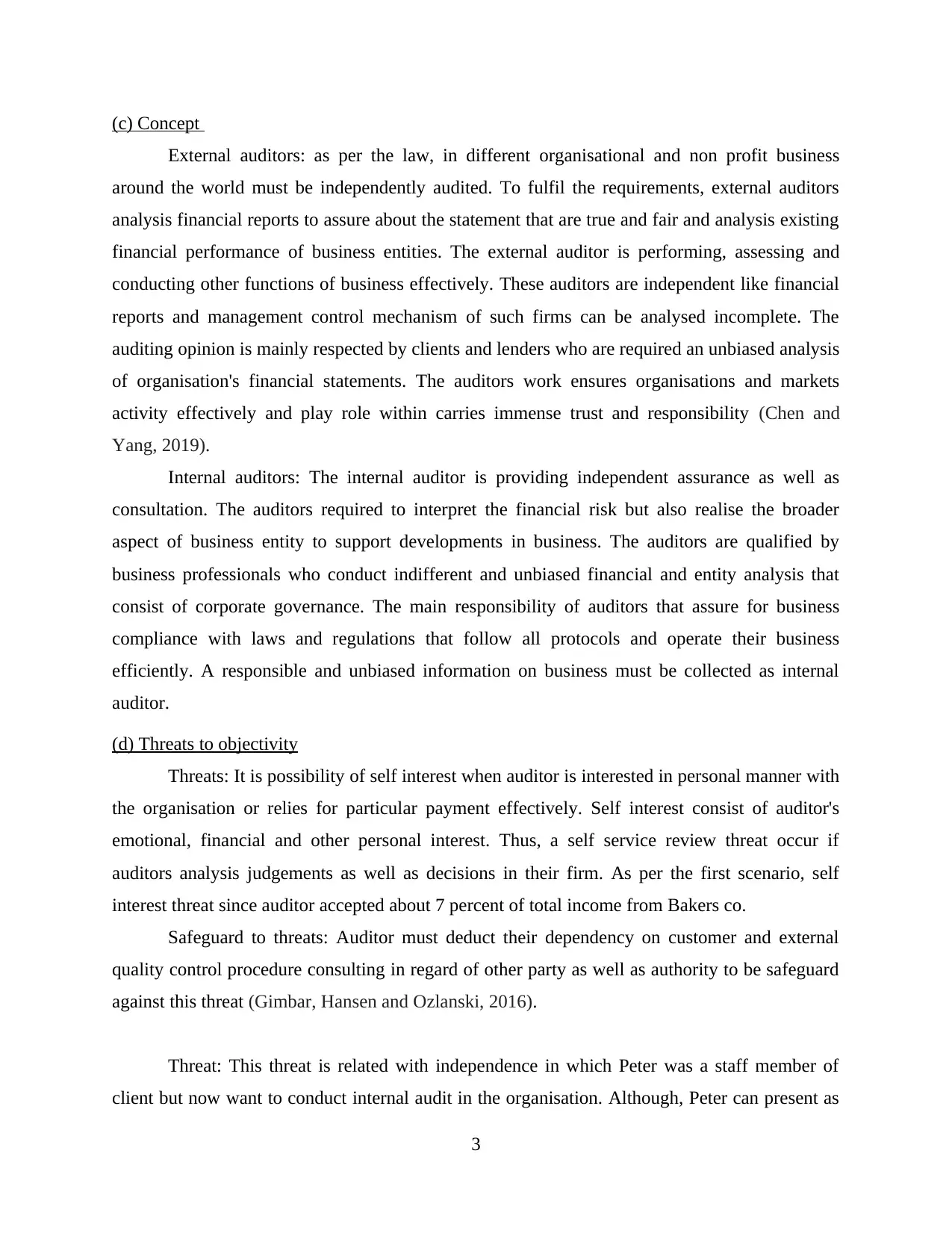
(c) Concept
External auditors: as per the law, in different organisational and non profit business
around the world must be independently audited. To fulfil the requirements, external auditors
analysis financial reports to assure about the statement that are true and fair and analysis existing
financial performance of business entities. The external auditor is performing, assessing and
conducting other functions of business effectively. These auditors are independent like financial
reports and management control mechanism of such firms can be analysed incomplete. The
auditing opinion is mainly respected by clients and lenders who are required an unbiased analysis
of organisation's financial statements. The auditors work ensures organisations and markets
activity effectively and play role within carries immense trust and responsibility (Chen and
Yang, 2019).
Internal auditors: The internal auditor is providing independent assurance as well as
consultation. The auditors required to interpret the financial risk but also realise the broader
aspect of business entity to support developments in business. The auditors are qualified by
business professionals who conduct indifferent and unbiased financial and entity analysis that
consist of corporate governance. The main responsibility of auditors that assure for business
compliance with laws and regulations that follow all protocols and operate their business
efficiently. A responsible and unbiased information on business must be collected as internal
auditor.
(d) Threats to objectivity
Threats: It is possibility of self interest when auditor is interested in personal manner with
the organisation or relies for particular payment effectively. Self interest consist of auditor's
emotional, financial and other personal interest. Thus, a self service review threat occur if
auditors analysis judgements as well as decisions in their firm. As per the first scenario, self
interest threat since auditor accepted about 7 percent of total income from Bakers co.
Safeguard to threats: Auditor must deduct their dependency on customer and external
quality control procedure consulting in regard of other party as well as authority to be safeguard
against this threat (Gimbar, Hansen and Ozlanski, 2016).
Threat: This threat is related with independence in which Peter was a staff member of
client but now want to conduct internal audit in the organisation. Although, Peter can present as
3
External auditors: as per the law, in different organisational and non profit business
around the world must be independently audited. To fulfil the requirements, external auditors
analysis financial reports to assure about the statement that are true and fair and analysis existing
financial performance of business entities. The external auditor is performing, assessing and
conducting other functions of business effectively. These auditors are independent like financial
reports and management control mechanism of such firms can be analysed incomplete. The
auditing opinion is mainly respected by clients and lenders who are required an unbiased analysis
of organisation's financial statements. The auditors work ensures organisations and markets
activity effectively and play role within carries immense trust and responsibility (Chen and
Yang, 2019).
Internal auditors: The internal auditor is providing independent assurance as well as
consultation. The auditors required to interpret the financial risk but also realise the broader
aspect of business entity to support developments in business. The auditors are qualified by
business professionals who conduct indifferent and unbiased financial and entity analysis that
consist of corporate governance. The main responsibility of auditors that assure for business
compliance with laws and regulations that follow all protocols and operate their business
efficiently. A responsible and unbiased information on business must be collected as internal
auditor.
(d) Threats to objectivity
Threats: It is possibility of self interest when auditor is interested in personal manner with
the organisation or relies for particular payment effectively. Self interest consist of auditor's
emotional, financial and other personal interest. Thus, a self service review threat occur if
auditors analysis judgements as well as decisions in their firm. As per the first scenario, self
interest threat since auditor accepted about 7 percent of total income from Bakers co.
Safeguard to threats: Auditor must deduct their dependency on customer and external
quality control procedure consulting in regard of other party as well as authority to be safeguard
against this threat (Gimbar, Hansen and Ozlanski, 2016).
Threat: This threat is related with independence in which Peter was a staff member of
client but now want to conduct internal audit in the organisation. Although, Peter can present as
3
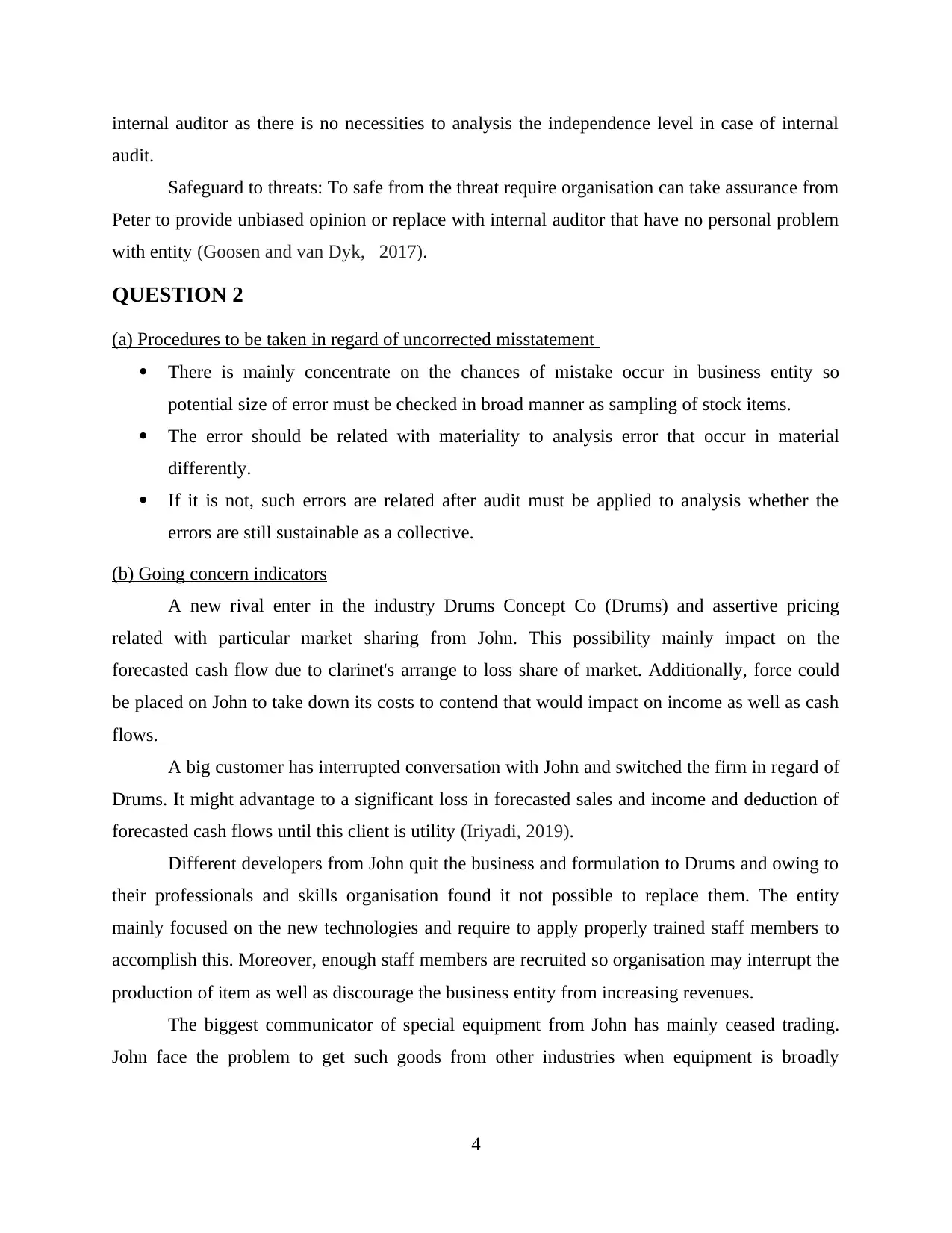
internal auditor as there is no necessities to analysis the independence level in case of internal
audit.
Safeguard to threats: To safe from the threat require organisation can take assurance from
Peter to provide unbiased opinion or replace with internal auditor that have no personal problem
with entity (Goosen and van Dyk, 2017).
QUESTION 2
(a) Procedures to be taken in regard of uncorrected misstatement
There is mainly concentrate on the chances of mistake occur in business entity so
potential size of error must be checked in broad manner as sampling of stock items.
The error should be related with materiality to analysis error that occur in material
differently.
If it is not, such errors are related after audit must be applied to analysis whether the
errors are still sustainable as a collective.
(b) Going concern indicators
A new rival enter in the industry Drums Concept Co (Drums) and assertive pricing
related with particular market sharing from John. This possibility mainly impact on the
forecasted cash flow due to clarinet's arrange to loss share of market. Additionally, force could
be placed on John to take down its costs to contend that would impact on income as well as cash
flows.
A big customer has interrupted conversation with John and switched the firm in regard of
Drums. It might advantage to a significant loss in forecasted sales and income and deduction of
forecasted cash flows until this client is utility (Iriyadi, 2019).
Different developers from John quit the business and formulation to Drums and owing to
their professionals and skills organisation found it not possible to replace them. The entity
mainly focused on the new technologies and require to apply properly trained staff members to
accomplish this. Moreover, enough staff members are recruited so organisation may interrupt the
production of item as well as discourage the business entity from increasing revenues.
The biggest communicator of special equipment from John has mainly ceased trading.
John face the problem to get such goods from other industries when equipment is broadly
4
audit.
Safeguard to threats: To safe from the threat require organisation can take assurance from
Peter to provide unbiased opinion or replace with internal auditor that have no personal problem
with entity (Goosen and van Dyk, 2017).
QUESTION 2
(a) Procedures to be taken in regard of uncorrected misstatement
There is mainly concentrate on the chances of mistake occur in business entity so
potential size of error must be checked in broad manner as sampling of stock items.
The error should be related with materiality to analysis error that occur in material
differently.
If it is not, such errors are related after audit must be applied to analysis whether the
errors are still sustainable as a collective.
(b) Going concern indicators
A new rival enter in the industry Drums Concept Co (Drums) and assertive pricing
related with particular market sharing from John. This possibility mainly impact on the
forecasted cash flow due to clarinet's arrange to loss share of market. Additionally, force could
be placed on John to take down its costs to contend that would impact on income as well as cash
flows.
A big customer has interrupted conversation with John and switched the firm in regard of
Drums. It might advantage to a significant loss in forecasted sales and income and deduction of
forecasted cash flows until this client is utility (Iriyadi, 2019).
Different developers from John quit the business and formulation to Drums and owing to
their professionals and skills organisation found it not possible to replace them. The entity
mainly focused on the new technologies and require to apply properly trained staff members to
accomplish this. Moreover, enough staff members are recruited so organisation may interrupt the
production of item as well as discourage the business entity from increasing revenues.
The biggest communicator of special equipment from John has mainly ceased trading.
John face the problem to get such goods from other industries when equipment is broadly
4
⊘ This is a preview!⊘
Do you want full access?
Subscribe today to unlock all pages.

Trusted by 1+ million students worldwide
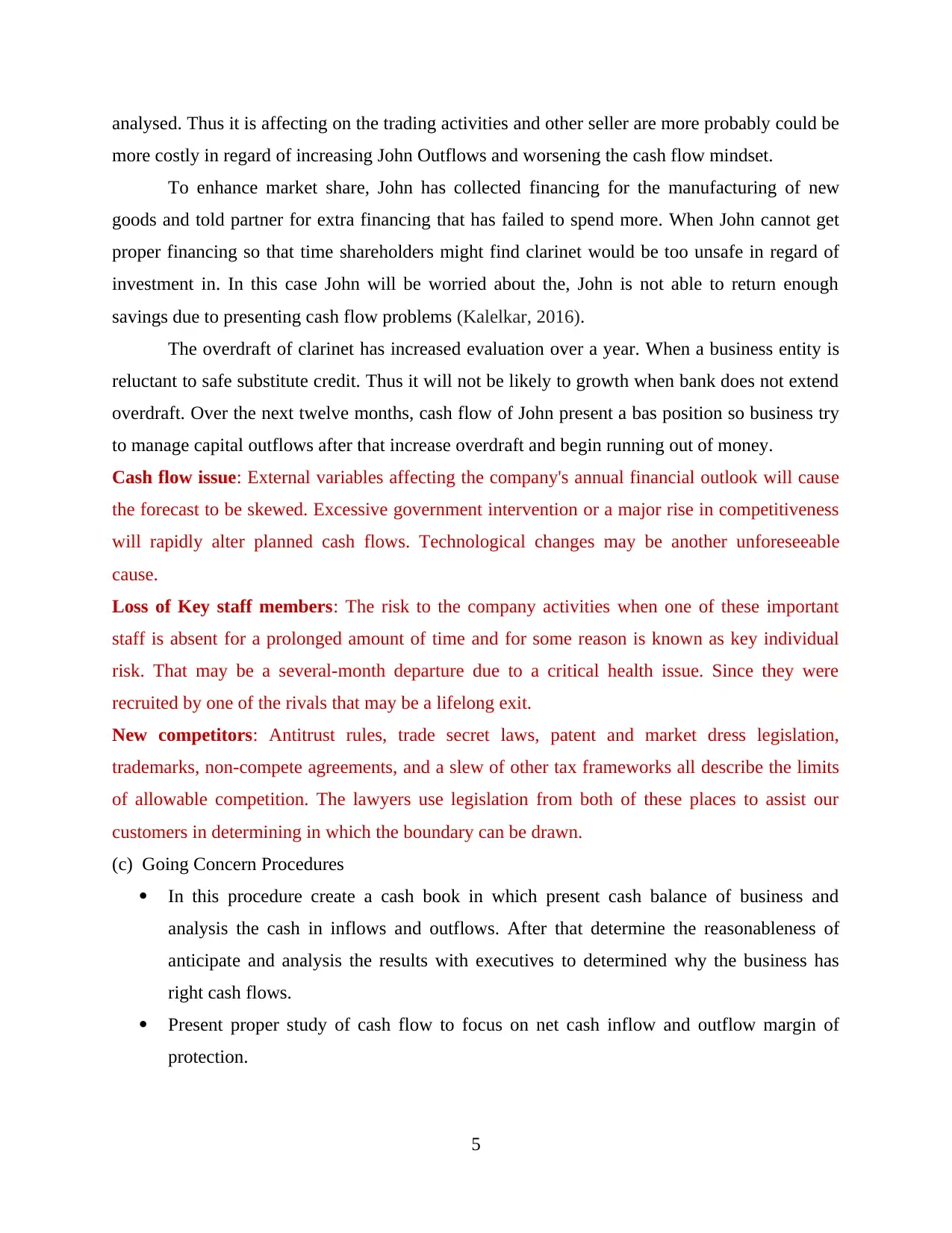
analysed. Thus it is affecting on the trading activities and other seller are more probably could be
more costly in regard of increasing John Outflows and worsening the cash flow mindset.
To enhance market share, John has collected financing for the manufacturing of new
goods and told partner for extra financing that has failed to spend more. When John cannot get
proper financing so that time shareholders might find clarinet would be too unsafe in regard of
investment in. In this case John will be worried about the, John is not able to return enough
savings due to presenting cash flow problems (Kalelkar, 2016).
The overdraft of clarinet has increased evaluation over a year. When a business entity is
reluctant to safe substitute credit. Thus it will not be likely to growth when bank does not extend
overdraft. Over the next twelve months, cash flow of John present a bas position so business try
to manage capital outflows after that increase overdraft and begin running out of money.
Cash flow issue: External variables affecting the company's annual financial outlook will cause
the forecast to be skewed. Excessive government intervention or a major rise in competitiveness
will rapidly alter planned cash flows. Technological changes may be another unforeseeable
cause.
Loss of Key staff members: The risk to the company activities when one of these important
staff is absent for a prolonged amount of time and for some reason is known as key individual
risk. That may be a several-month departure due to a critical health issue. Since they were
recruited by one of the rivals that may be a lifelong exit.
New competitors: Antitrust rules, trade secret laws, patent and market dress legislation,
trademarks, non-compete agreements, and a slew of other tax frameworks all describe the limits
of allowable competition. The lawyers use legislation from both of these places to assist our
customers in determining in which the boundary can be drawn.
(c) Going Concern Procedures
In this procedure create a cash book in which present cash balance of business and
analysis the cash in inflows and outflows. After that determine the reasonableness of
anticipate and analysis the results with executives to determined why the business has
right cash flows.
Present proper study of cash flow to focus on net cash inflow and outflow margin of
protection.
5
more costly in regard of increasing John Outflows and worsening the cash flow mindset.
To enhance market share, John has collected financing for the manufacturing of new
goods and told partner for extra financing that has failed to spend more. When John cannot get
proper financing so that time shareholders might find clarinet would be too unsafe in regard of
investment in. In this case John will be worried about the, John is not able to return enough
savings due to presenting cash flow problems (Kalelkar, 2016).
The overdraft of clarinet has increased evaluation over a year. When a business entity is
reluctant to safe substitute credit. Thus it will not be likely to growth when bank does not extend
overdraft. Over the next twelve months, cash flow of John present a bas position so business try
to manage capital outflows after that increase overdraft and begin running out of money.
Cash flow issue: External variables affecting the company's annual financial outlook will cause
the forecast to be skewed. Excessive government intervention or a major rise in competitiveness
will rapidly alter planned cash flows. Technological changes may be another unforeseeable
cause.
Loss of Key staff members: The risk to the company activities when one of these important
staff is absent for a prolonged amount of time and for some reason is known as key individual
risk. That may be a several-month departure due to a critical health issue. Since they were
recruited by one of the rivals that may be a lifelong exit.
New competitors: Antitrust rules, trade secret laws, patent and market dress legislation,
trademarks, non-compete agreements, and a slew of other tax frameworks all describe the limits
of allowable competition. The lawyers use legislation from both of these places to assist our
customers in determining in which the boundary can be drawn.
(c) Going Concern Procedures
In this procedure create a cash book in which present cash balance of business and
analysis the cash in inflows and outflows. After that determine the reasonableness of
anticipate and analysis the results with executives to determined why the business has
right cash flows.
Present proper study of cash flow to focus on net cash inflow and outflow margin of
protection.
5
Paraphrase This Document
Need a fresh take? Get an instant paraphrase of this document with our AI Paraphraser
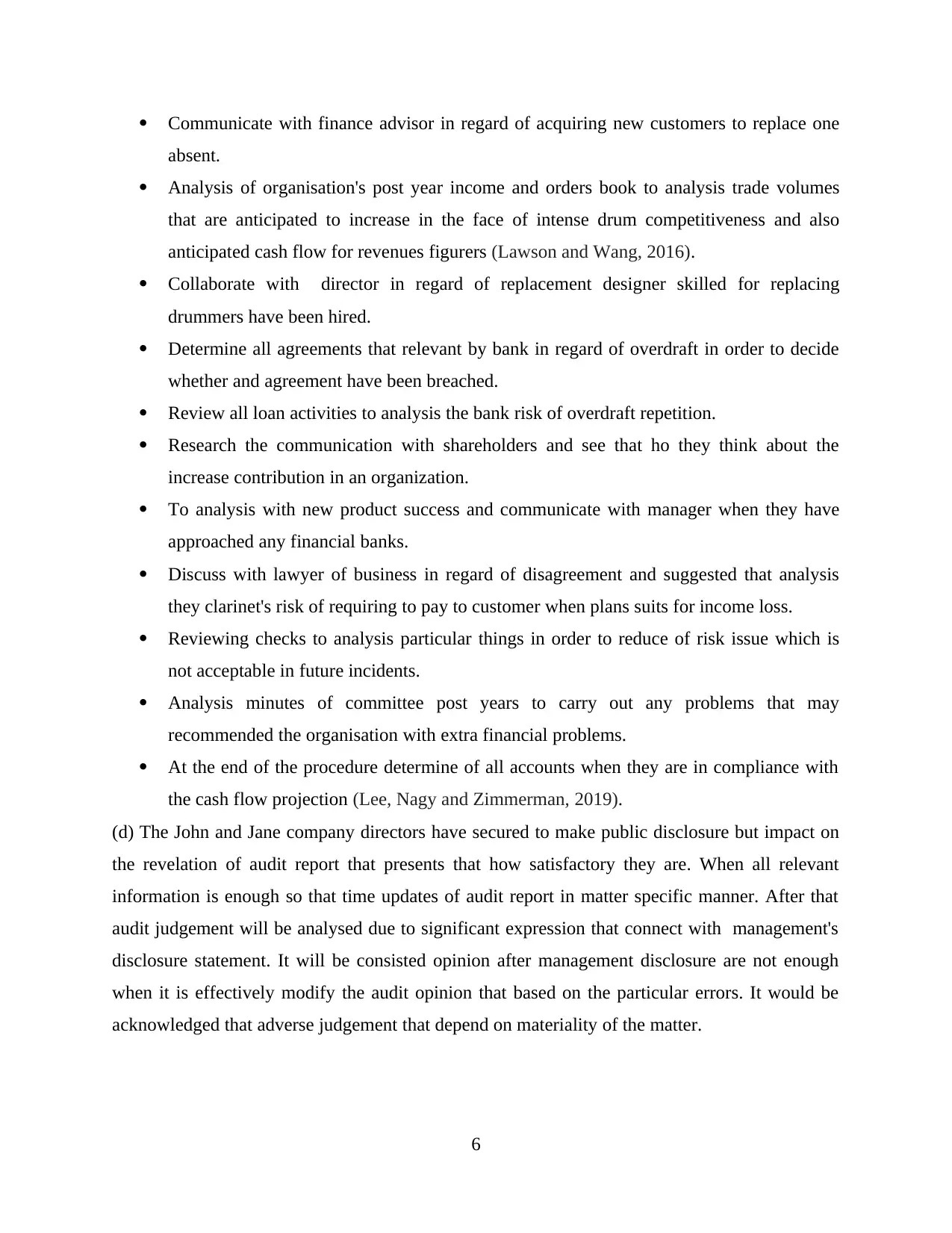
Communicate with finance advisor in regard of acquiring new customers to replace one
absent.
Analysis of organisation's post year income and orders book to analysis trade volumes
that are anticipated to increase in the face of intense drum competitiveness and also
anticipated cash flow for revenues figurers (Lawson and Wang, 2016).
Collaborate with director in regard of replacement designer skilled for replacing
drummers have been hired.
Determine all agreements that relevant by bank in regard of overdraft in order to decide
whether and agreement have been breached.
Review all loan activities to analysis the bank risk of overdraft repetition.
Research the communication with shareholders and see that ho they think about the
increase contribution in an organization.
To analysis with new product success and communicate with manager when they have
approached any financial banks.
Discuss with lawyer of business in regard of disagreement and suggested that analysis
they clarinet's risk of requiring to pay to customer when plans suits for income loss.
Reviewing checks to analysis particular things in order to reduce of risk issue which is
not acceptable in future incidents.
Analysis minutes of committee post years to carry out any problems that may
recommended the organisation with extra financial problems.
At the end of the procedure determine of all accounts when they are in compliance with
the cash flow projection (Lee, Nagy and Zimmerman, 2019).
(d) The John and Jane company directors have secured to make public disclosure but impact on
the revelation of audit report that presents that how satisfactory they are. When all relevant
information is enough so that time updates of audit report in matter specific manner. After that
audit judgement will be analysed due to significant expression that connect with management's
disclosure statement. It will be consisted opinion after management disclosure are not enough
when it is effectively modify the audit opinion that based on the particular errors. It would be
acknowledged that adverse judgement that depend on materiality of the matter.
6
absent.
Analysis of organisation's post year income and orders book to analysis trade volumes
that are anticipated to increase in the face of intense drum competitiveness and also
anticipated cash flow for revenues figurers (Lawson and Wang, 2016).
Collaborate with director in regard of replacement designer skilled for replacing
drummers have been hired.
Determine all agreements that relevant by bank in regard of overdraft in order to decide
whether and agreement have been breached.
Review all loan activities to analysis the bank risk of overdraft repetition.
Research the communication with shareholders and see that ho they think about the
increase contribution in an organization.
To analysis with new product success and communicate with manager when they have
approached any financial banks.
Discuss with lawyer of business in regard of disagreement and suggested that analysis
they clarinet's risk of requiring to pay to customer when plans suits for income loss.
Reviewing checks to analysis particular things in order to reduce of risk issue which is
not acceptable in future incidents.
Analysis minutes of committee post years to carry out any problems that may
recommended the organisation with extra financial problems.
At the end of the procedure determine of all accounts when they are in compliance with
the cash flow projection (Lee, Nagy and Zimmerman, 2019).
(d) The John and Jane company directors have secured to make public disclosure but impact on
the revelation of audit report that presents that how satisfactory they are. When all relevant
information is enough so that time updates of audit report in matter specific manner. After that
audit judgement will be analysed due to significant expression that connect with management's
disclosure statement. It will be consisted opinion after management disclosure are not enough
when it is effectively modify the audit opinion that based on the particular errors. It would be
acknowledged that adverse judgement that depend on materiality of the matter.
6
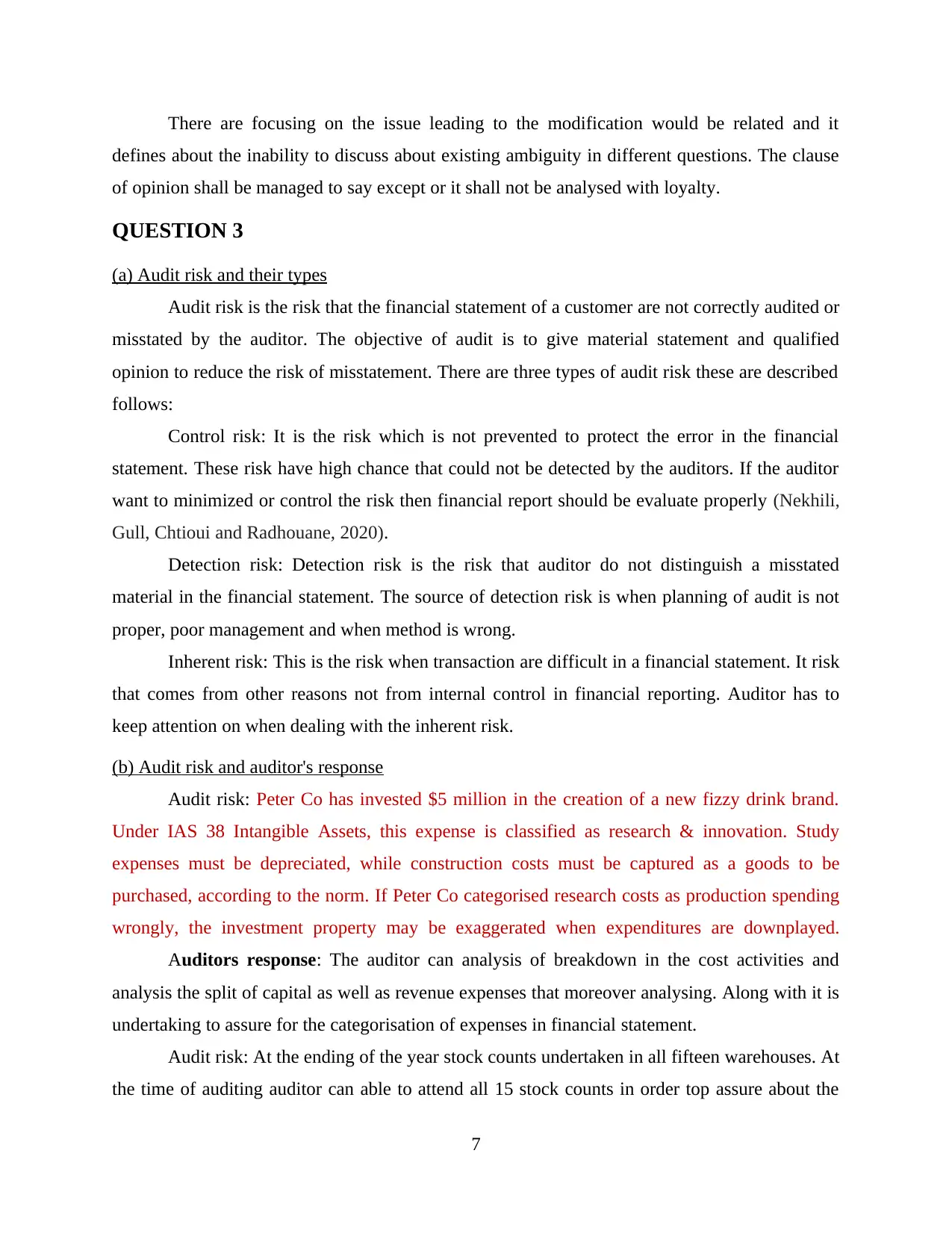
There are focusing on the issue leading to the modification would be related and it
defines about the inability to discuss about existing ambiguity in different questions. The clause
of opinion shall be managed to say except or it shall not be analysed with loyalty.
QUESTION 3
(a) Audit risk and their types
Audit risk is the risk that the financial statement of a customer are not correctly audited or
misstated by the auditor. The objective of audit is to give material statement and qualified
opinion to reduce the risk of misstatement. There are three types of audit risk these are described
follows:
Control risk: It is the risk which is not prevented to protect the error in the financial
statement. These risk have high chance that could not be detected by the auditors. If the auditor
want to minimized or control the risk then financial report should be evaluate properly (Nekhili,
Gull, Chtioui and Radhouane, 2020).
Detection risk: Detection risk is the risk that auditor do not distinguish a misstated
material in the financial statement. The source of detection risk is when planning of audit is not
proper, poor management and when method is wrong.
Inherent risk: This is the risk when transaction are difficult in a financial statement. It risk
that comes from other reasons not from internal control in financial reporting. Auditor has to
keep attention on when dealing with the inherent risk.
(b) Audit risk and auditor's response
Audit risk: Peter Co has invested $5 million in the creation of a new fizzy drink brand.
Under IAS 38 Intangible Assets, this expense is classified as research & innovation. Study
expenses must be depreciated, while construction costs must be captured as a goods to be
purchased, according to the norm. If Peter Co categorised research costs as production spending
wrongly, the investment property may be exaggerated when expenditures are downplayed.
Auditors response: The auditor can analysis of breakdown in the cost activities and
analysis the split of capital as well as revenue expenses that moreover analysing. Along with it is
undertaking to assure for the categorisation of expenses in financial statement.
Audit risk: At the ending of the year stock counts undertaken in all fifteen warehouses. At
the time of auditing auditor can able to attend all 15 stock counts in order top assure about the
7
defines about the inability to discuss about existing ambiguity in different questions. The clause
of opinion shall be managed to say except or it shall not be analysed with loyalty.
QUESTION 3
(a) Audit risk and their types
Audit risk is the risk that the financial statement of a customer are not correctly audited or
misstated by the auditor. The objective of audit is to give material statement and qualified
opinion to reduce the risk of misstatement. There are three types of audit risk these are described
follows:
Control risk: It is the risk which is not prevented to protect the error in the financial
statement. These risk have high chance that could not be detected by the auditors. If the auditor
want to minimized or control the risk then financial report should be evaluate properly (Nekhili,
Gull, Chtioui and Radhouane, 2020).
Detection risk: Detection risk is the risk that auditor do not distinguish a misstated
material in the financial statement. The source of detection risk is when planning of audit is not
proper, poor management and when method is wrong.
Inherent risk: This is the risk when transaction are difficult in a financial statement. It risk
that comes from other reasons not from internal control in financial reporting. Auditor has to
keep attention on when dealing with the inherent risk.
(b) Audit risk and auditor's response
Audit risk: Peter Co has invested $5 million in the creation of a new fizzy drink brand.
Under IAS 38 Intangible Assets, this expense is classified as research & innovation. Study
expenses must be depreciated, while construction costs must be captured as a goods to be
purchased, according to the norm. If Peter Co categorised research costs as production spending
wrongly, the investment property may be exaggerated when expenditures are downplayed.
Auditors response: The auditor can analysis of breakdown in the cost activities and
analysis the split of capital as well as revenue expenses that moreover analysing. Along with it is
undertaking to assure for the categorisation of expenses in financial statement.
Audit risk: At the ending of the year stock counts undertaken in all fifteen warehouses. At
the time of auditing auditor can able to attend all 15 stock counts in order top assure about the
7
⊘ This is a preview!⊘
Do you want full access?
Subscribe today to unlock all pages.

Trusted by 1+ million students worldwide
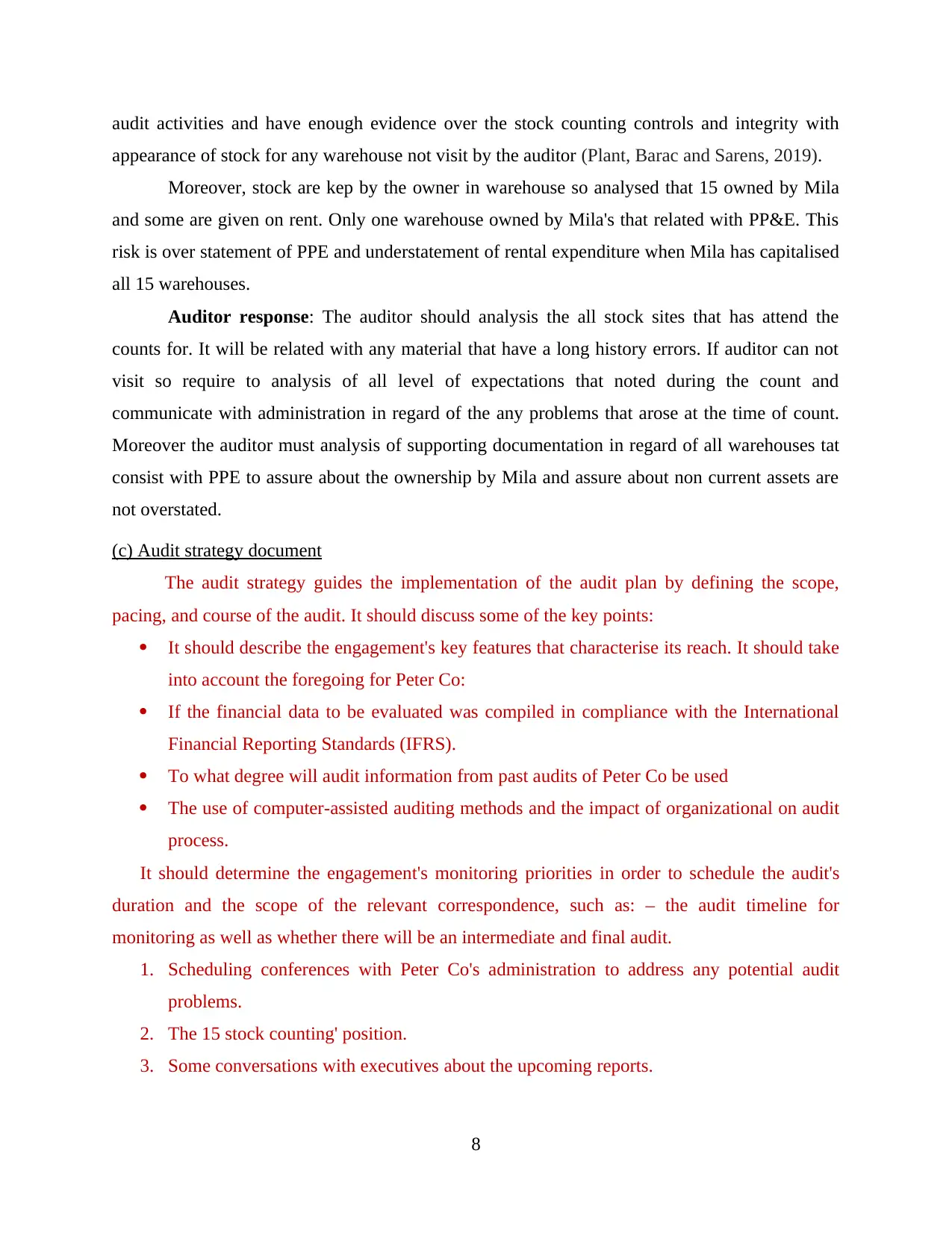
audit activities and have enough evidence over the stock counting controls and integrity with
appearance of stock for any warehouse not visit by the auditor (Plant, Barac and Sarens, 2019).
Moreover, stock are kep by the owner in warehouse so analysed that 15 owned by Mila
and some are given on rent. Only one warehouse owned by Mila's that related with PP&E. This
risk is over statement of PPE and understatement of rental expenditure when Mila has capitalised
all 15 warehouses.
Auditor response: The auditor should analysis the all stock sites that has attend the
counts for. It will be related with any material that have a long history errors. If auditor can not
visit so require to analysis of all level of expectations that noted during the count and
communicate with administration in regard of the any problems that arose at the time of count.
Moreover the auditor must analysis of supporting documentation in regard of all warehouses tat
consist with PPE to assure about the ownership by Mila and assure about non current assets are
not overstated.
(c) Audit strategy document
The audit strategy guides the implementation of the audit plan by defining the scope,
pacing, and course of the audit. It should discuss some of the key points:
It should describe the engagement's key features that characterise its reach. It should take
into account the foregoing for Peter Co:
If the financial data to be evaluated was compiled in compliance with the International
Financial Reporting Standards (IFRS).
To what degree will audit information from past audits of Peter Co be used
The use of computer-assisted auditing methods and the impact of organizational on audit
process.
It should determine the engagement's monitoring priorities in order to schedule the audit's
duration and the scope of the relevant correspondence, such as: – the audit timeline for
monitoring as well as whether there will be an intermediate and final audit.
1. Scheduling conferences with Peter Co's administration to address any potential audit
problems.
2. The 15 stock counting' position.
3. Some conversations with executives about the upcoming reports.
8
appearance of stock for any warehouse not visit by the auditor (Plant, Barac and Sarens, 2019).
Moreover, stock are kep by the owner in warehouse so analysed that 15 owned by Mila
and some are given on rent. Only one warehouse owned by Mila's that related with PP&E. This
risk is over statement of PPE and understatement of rental expenditure when Mila has capitalised
all 15 warehouses.
Auditor response: The auditor should analysis the all stock sites that has attend the
counts for. It will be related with any material that have a long history errors. If auditor can not
visit so require to analysis of all level of expectations that noted during the count and
communicate with administration in regard of the any problems that arose at the time of count.
Moreover the auditor must analysis of supporting documentation in regard of all warehouses tat
consist with PPE to assure about the ownership by Mila and assure about non current assets are
not overstated.
(c) Audit strategy document
The audit strategy guides the implementation of the audit plan by defining the scope,
pacing, and course of the audit. It should discuss some of the key points:
It should describe the engagement's key features that characterise its reach. It should take
into account the foregoing for Peter Co:
If the financial data to be evaluated was compiled in compliance with the International
Financial Reporting Standards (IFRS).
To what degree will audit information from past audits of Peter Co be used
The use of computer-assisted auditing methods and the impact of organizational on audit
process.
It should determine the engagement's monitoring priorities in order to schedule the audit's
duration and the scope of the relevant correspondence, such as: – the audit timeline for
monitoring as well as whether there will be an intermediate and final audit.
1. Scheduling conferences with Peter Co's administration to address any potential audit
problems.
2. The 15 stock counting' position.
3. Some conversations with executives about the upcoming reports.
8
Paraphrase This Document
Need a fresh take? Get an instant paraphrase of this document with our AI Paraphraser
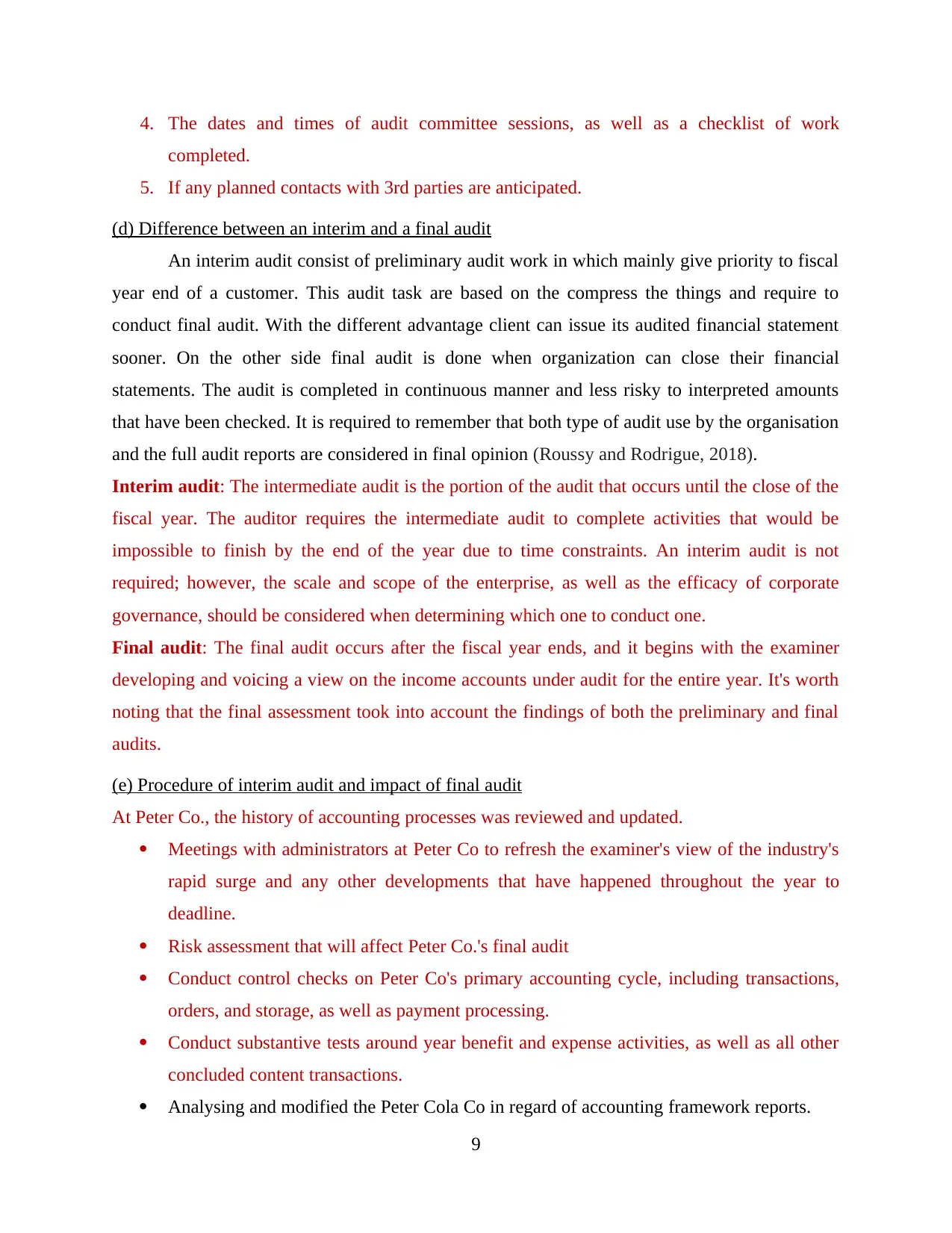
4. The dates and times of audit committee sessions, as well as a checklist of work
completed.
5. If any planned contacts with 3rd parties are anticipated.
(d) Difference between an interim and a final audit
An interim audit consist of preliminary audit work in which mainly give priority to fiscal
year end of a customer. This audit task are based on the compress the things and require to
conduct final audit. With the different advantage client can issue its audited financial statement
sooner. On the other side final audit is done when organization can close their financial
statements. The audit is completed in continuous manner and less risky to interpreted amounts
that have been checked. It is required to remember that both type of audit use by the organisation
and the full audit reports are considered in final opinion (Roussy and Rodrigue, 2018).
Interim audit: The intermediate audit is the portion of the audit that occurs until the close of the
fiscal year. The auditor requires the intermediate audit to complete activities that would be
impossible to finish by the end of the year due to time constraints. An interim audit is not
required; however, the scale and scope of the enterprise, as well as the efficacy of corporate
governance, should be considered when determining which one to conduct one.
Final audit: The final audit occurs after the fiscal year ends, and it begins with the examiner
developing and voicing a view on the income accounts under audit for the entire year. It's worth
noting that the final assessment took into account the findings of both the preliminary and final
audits.
(e) Procedure of interim audit and impact of final audit
At Peter Co., the history of accounting processes was reviewed and updated.
Meetings with administrators at Peter Co to refresh the examiner's view of the industry's
rapid surge and any other developments that have happened throughout the year to
deadline.
Risk assessment that will affect Peter Co.'s final audit
Conduct control checks on Peter Co's primary accounting cycle, including transactions,
orders, and storage, as well as payment processing.
Conduct substantive tests around year benefit and expense activities, as well as all other
concluded content transactions.
Analysing and modified the Peter Cola Co in regard of accounting framework reports.
9
completed.
5. If any planned contacts with 3rd parties are anticipated.
(d) Difference between an interim and a final audit
An interim audit consist of preliminary audit work in which mainly give priority to fiscal
year end of a customer. This audit task are based on the compress the things and require to
conduct final audit. With the different advantage client can issue its audited financial statement
sooner. On the other side final audit is done when organization can close their financial
statements. The audit is completed in continuous manner and less risky to interpreted amounts
that have been checked. It is required to remember that both type of audit use by the organisation
and the full audit reports are considered in final opinion (Roussy and Rodrigue, 2018).
Interim audit: The intermediate audit is the portion of the audit that occurs until the close of the
fiscal year. The auditor requires the intermediate audit to complete activities that would be
impossible to finish by the end of the year due to time constraints. An interim audit is not
required; however, the scale and scope of the enterprise, as well as the efficacy of corporate
governance, should be considered when determining which one to conduct one.
Final audit: The final audit occurs after the fiscal year ends, and it begins with the examiner
developing and voicing a view on the income accounts under audit for the entire year. It's worth
noting that the final assessment took into account the findings of both the preliminary and final
audits.
(e) Procedure of interim audit and impact of final audit
At Peter Co., the history of accounting processes was reviewed and updated.
Meetings with administrators at Peter Co to refresh the examiner's view of the industry's
rapid surge and any other developments that have happened throughout the year to
deadline.
Risk assessment that will affect Peter Co.'s final audit
Conduct control checks on Peter Co's primary accounting cycle, including transactions,
orders, and storage, as well as payment processing.
Conduct substantive tests around year benefit and expense activities, as well as all other
concluded content transactions.
Analysing and modified the Peter Cola Co in regard of accounting framework reports.
9
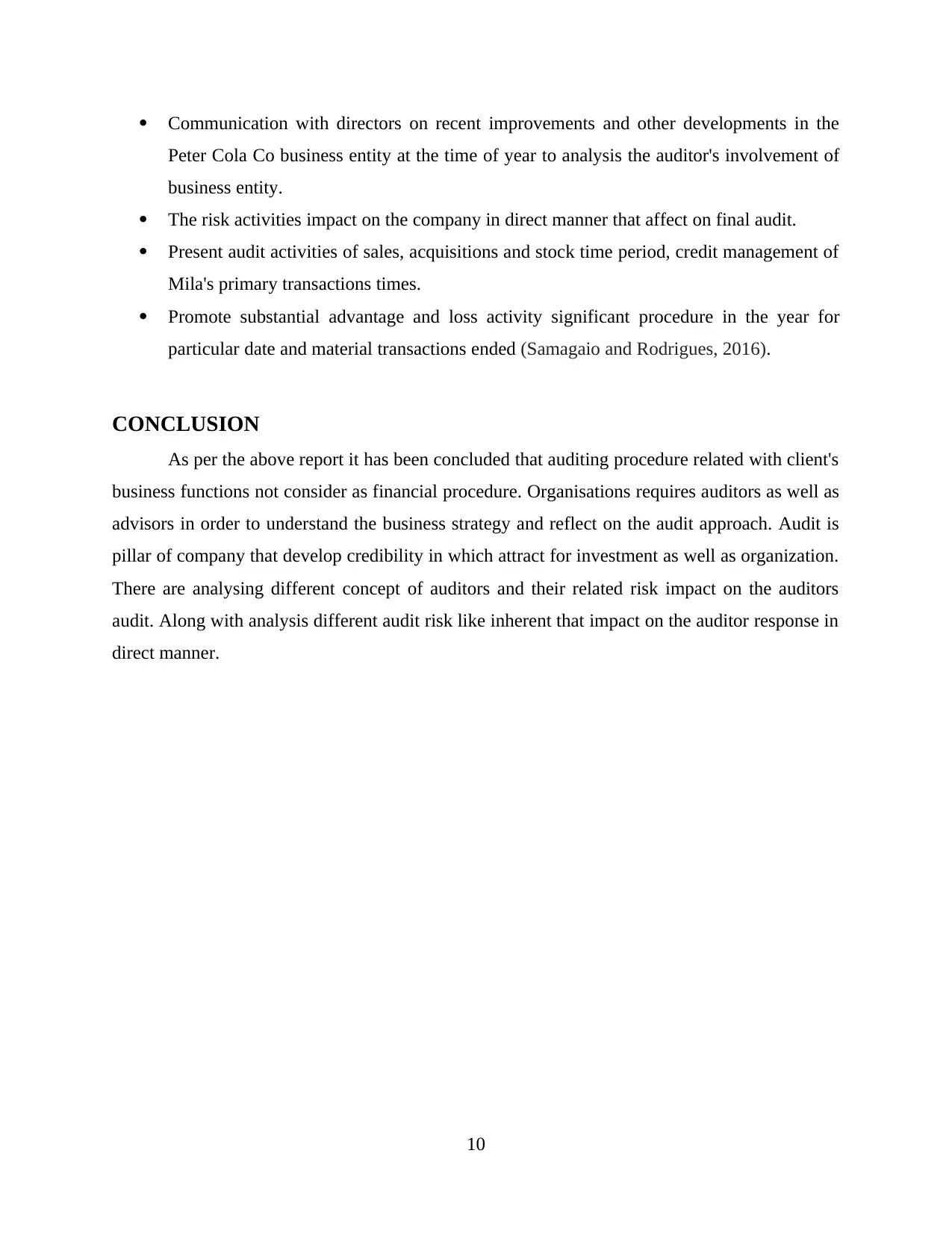
Communication with directors on recent improvements and other developments in the
Peter Cola Co business entity at the time of year to analysis the auditor's involvement of
business entity.
The risk activities impact on the company in direct manner that affect on final audit.
Present audit activities of sales, acquisitions and stock time period, credit management of
Mila's primary transactions times.
Promote substantial advantage and loss activity significant procedure in the year for
particular date and material transactions ended (Samagaio and Rodrigues, 2016).
CONCLUSION
As per the above report it has been concluded that auditing procedure related with client's
business functions not consider as financial procedure. Organisations requires auditors as well as
advisors in order to understand the business strategy and reflect on the audit approach. Audit is
pillar of company that develop credibility in which attract for investment as well as organization.
There are analysing different concept of auditors and their related risk impact on the auditors
audit. Along with analysis different audit risk like inherent that impact on the auditor response in
direct manner.
10
Peter Cola Co business entity at the time of year to analysis the auditor's involvement of
business entity.
The risk activities impact on the company in direct manner that affect on final audit.
Present audit activities of sales, acquisitions and stock time period, credit management of
Mila's primary transactions times.
Promote substantial advantage and loss activity significant procedure in the year for
particular date and material transactions ended (Samagaio and Rodrigues, 2016).
CONCLUSION
As per the above report it has been concluded that auditing procedure related with client's
business functions not consider as financial procedure. Organisations requires auditors as well as
advisors in order to understand the business strategy and reflect on the audit approach. Audit is
pillar of company that develop credibility in which attract for investment as well as organization.
There are analysing different concept of auditors and their related risk impact on the auditors
audit. Along with analysis different audit risk like inherent that impact on the auditor response in
direct manner.
10
⊘ This is a preview!⊘
Do you want full access?
Subscribe today to unlock all pages.

Trusted by 1+ million students worldwide
1 out of 14
Related Documents
Your All-in-One AI-Powered Toolkit for Academic Success.
+13062052269
info@desklib.com
Available 24*7 on WhatsApp / Email
![[object Object]](/_next/static/media/star-bottom.7253800d.svg)
Unlock your academic potential
Copyright © 2020–2025 A2Z Services. All Rights Reserved. Developed and managed by ZUCOL.





